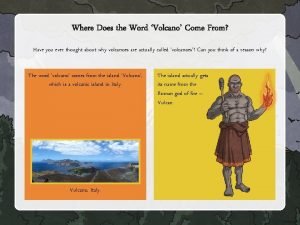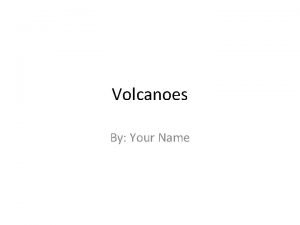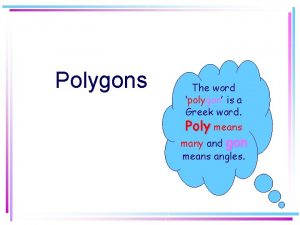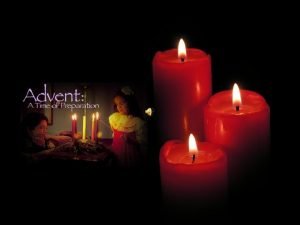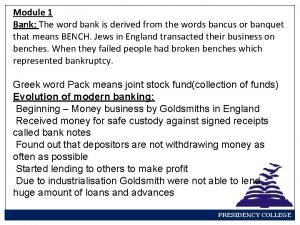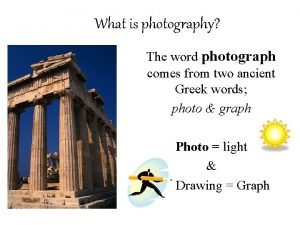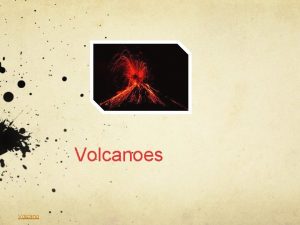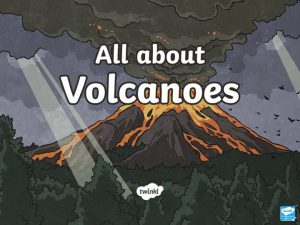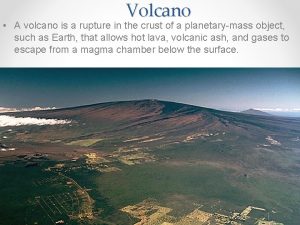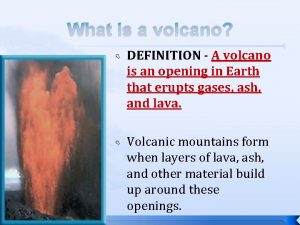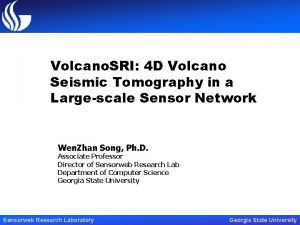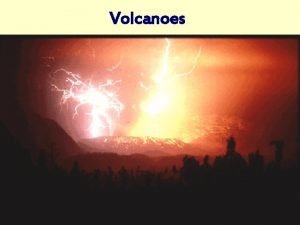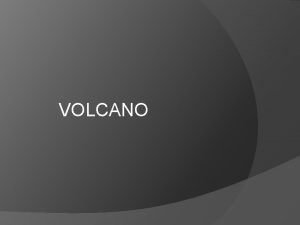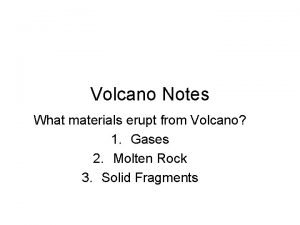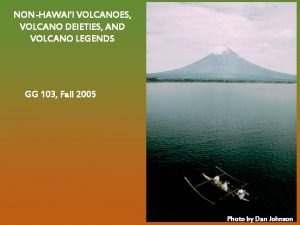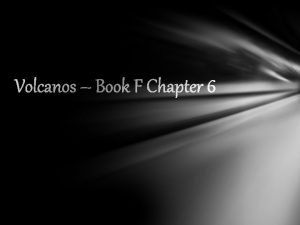Where Does the Word Volcano Come From Have














- Slides: 14

Where Does the Word ‘Volcano’ Come From? Have you ever thought about why volcanoes are actually called 'volcanoes'? Can you think of a reason why? The word 'volcano' comes from the island ‘Vulcano’, which is a volcanic island in Italy. Vulcano, Italy. The island actually gets its name from the Roman god of fire – Vulcan.

What Is Our Earth Made Of? Click on the circles to reveal the information. The Outer Core The outer core is a liquid layer made out of molten iron and nickel. This liquid metal creates the earth's +× magnetic ×+field. ×+ The Mantle The mantle is approximately 2897 km thick and is made of a solid, rocky substance called molten rock or magma. This is what escapes when a volcano erupts. +× The Inner Core This is a solid layer and is made of iron and nickel. It is the hottest part of the earth and can reach temperatures of up to 5500ºC! The Crust This is the outer layer of the earth. It varies in thickness from 0 – 60 km thick. It is not even and is made up of pieces which overlap to cover the entire planet. These pieces are called ‘tectonic plates’.

Where Are Most Volcanoes Located? The ‘Ring of Fire’ is an area of the Pacific Ocean that is shaped like a horseshoe. It is home to 90% of the world's earthquakes and 75% of the world's volcanoes. It contains a string of 452 volcanoes, which stretches from the southern tip of South America, up along the coast of North America, down through Japan, and into New Zealand.

How Are Volcanoes Formed? Deep in the earth, it is extremely hot. It is so hot, in fact, that rocks actually melt and form magma, which makes up the mantle of the earth. The upper mantle mixes and moves, which creates pressure underneath the crust. This pressure can sometimes cause the mantle to leak out onto the surface of the earth – this is a volcano! Over time, as this magma leaks out, the volcano will get bigger and bigger.

The Three Stages of Volcanoes Scientists have placed volcanoes in to three different categories. What do you think each one is? Active An active volcano is one that has erupted recently, and there is the possibility that it may erupt again. Dormant A dormant volcano is one that has not erupted for a long time, however, it may still erupt in the future. Extinct An extinct volcano is one which has erupted thousands of years ago, but it will probably never erupt again.

Why Do Volcanoes Erupt? We know that the earth's crust is made up of huge slabs called tectonic plates. These fit together like a jigsaw puzzle and they sometimes move. Friction: the resistance created when one surface rubs Click on the word in bold to find out what it against another. means! The movement causes friction which causes earthquakes and volcanic eruptions near the edges of the plates. The theory that explains this process is called ‘plate tectonics’ – this means the plates are moving in different directions and at different speeds. Sometimes they collide or brush past each other and cause these earthquakes and volcanic eruptions.

What Are the Different Parts of a Volcano? Click on each label to find out more. Click again to remove. vent ash cloud crater A cloud of ash. It is formed by An opening in the surface of the volcanic explosions Earth through which volcanic The mouth of a volcano. It surrounds materials, such as magma, can escape. the vent. throat conduit An underground passage which magma travels through. A large underground pool of liquid rock found beneath the surface of the Earth. magma reservoir The entrance of a volcano. It ejects lava and volcanic ash.

How Many Volcanoes Are There? There are more than 1500 active volcanoes on Earth. There also more than 80 volcanoes under the ocean, although these are just the ones that have been discovered.

What Types of Volcano Are There? Mount St. Helens in Washington, USA is a composite volcano. Composite Volcanoes These volcanoes are steep-sided volcanoes and are made up of lots of layers of volcanic rocks. They usually erupt in an explosive way because the magma in these volcanoes is quite sticky. It clogs up the passage that it has to pass through. Pressure is built inside the volcanic chamber and this results in the volcano erupting violently.

What Types of Volcano Are There? Sunset Crater in Arizona, USA is a cinder cone. Cinder Cones Cinder cones are circular or oval cones. They are made up of small fragments of lava, which are blown into the air through a single vent. When they cool down, they form rock around the vent. They grow quickly, but are not usually very big. They are not usually dangerous either.

What Types of Volcano Are There? Shield Volcanoes like this one in Hawaii are common in this part of the world. Shield Volcanoes Shield volcanoes are bowl or shield-shaped in the middle. When they erupt, the lava is quite runny and it travels long distances down the side of the volcano before it cools down. This lava forms long, gentle slopes that look like a warrior's shield, which is how they got their name. These volcanoes do not often explode.

Volcanoes of the World Mount St Helens × 1 × 2 Mount St Helens is an active volcano located in Washington, USA in the Cascade Mountain Range. × 3 On 18 th May 1980, it erupted and killed 57 people and destroyed lots of roads and homes. × 4 × 5 This was the first time pyroclastic flows (the St Helens is still active, and. Anis earthquake triggered a landslide, which Mount caused ifa sideways blast, sending clouds of ash, clouds of hot gas, ash and rock) were studied closely by geologists to predict monitored using new scientific techniques. it will erupt again. gas and rock speeding away from the volcano. Click on the numbers to reveal the facts.

Volcanoes of the World Mount Vesuvius, Naples, Italy × 1 × 2 Mount Vesuvius has a very famous history. Its base is 30 miles wide and it is estimated to be around 17, 000 years old. × 3 In 79 AD, Vesuvius erupted for a whole day. Thousands of people were killed, and the city of Pompeii was buried. × 4 × 5 Over the years, archaeologists have found Vesuvius has erupted over 50 times inbodies the last preserved by the ash from the volcano In 1995, Vesuvius was made a National Park. 200 years. The last time was in 1944 during the other items, such as heating stoves along with Visitors can climb the mountain. Second World War. and cooking utensils. Click on the numbers to reveal the facts.

Volcanoes of the World Mount Fuji, Japan × 1 × 2 Mount Fuji is the highest mountain in Japan. It is 3776 m high. It is on the island of Honshu, about 100 km from Tokyo. × 3 Over 100, 000 people climb Mount Fuji every year. It is the most climbed mountain in the world. × 4 × 5 Mount Fuji last erupted in 1708. It has A forest named Aokigahara lies at The the volcano is actually three separatebecome a symbol of the country and is foot of the mountain and is said tovolcanoes be piled one on top of the other featured in lots of paintings. haunted by ghosts and goblins. with Fuji at the top. Click on the numbers to reveal the facts.
 Where does the word “volcano” come from? *
Where does the word “volcano” come from? * Lava plateaus form when _____.
Lava plateaus form when _____. Mogans cevicheria
Mogans cevicheria Where the word psychology does come from?
Where the word psychology does come from? Polygon formulas
Polygon formulas The word theatre comes from
The word theatre comes from As400 wikipedia
As400 wikipedia Differences between play and drama
Differences between play and drama Advent comes from the latin word adventus which means what
Advent comes from the latin word adventus which means what Where does the word scouser come from
Where does the word scouser come from Where did the word bank come from
Where did the word bank come from Fax correspondence
Fax correspondence The word photography comes from the greek words
The word photography comes from the greek words Polygon
Polygon 6 vertices and 6 faces
6 vertices and 6 faces
